Documenting Reasons for Optimism: Mitigating Climate Change through Soil Restoration
It is important to document reasons for optimism, focusing on the future we want to achieve. Several trends, in particular trends regarding soil regeneration, support optimism about the environment. We need to build upon these positive trends, while resisting the negative ones.
For years while I was in Geneva, Switzerland, I published and edited the Worldwatch Institute’s World Watch magazine and annual State of the World report. Worldwatch was founded by Lester Brown, who also founded the Earth Policy Institute, and it has done a remarkable job monitoring the environmental crisis and promoting solutions to it. It promoted concepts that were obscure at the time but are now widely used, such as “nature’s services” and “low carbon economies.” Publishing in some forty languages, the Washington, DC–based institute proposes “a vision for a sustainable world.”
When I worked with them, solar and wind energies were just a drop in a bucket in terms of electricity output, with prices far above conventional electricity. Ahead of everyone, against the prevailing perspective, Worldwatch defended what is now the fastest growing industry in many parts of the world. While the replacement of a fossil fuel-based economy by renewable energy is not yet a reality, the possibility of 100% renewables in coming decades is increasingly taken seriously. A small garage owner in Bromont, Quebec, selling solar panels for chalets and RVs told me recently, “I used to sell this solar panel for 1200 CAD five year ago. Now it sells for 300, and it is more efficient. I even remember selling it for 2500 CAD.” Recent positive trends such as these — which have been documented in the fields of renewable energy, recycling, the reduction of pollution in cities, environmental regulations, and more — feed optimism.
 Our job now is to do the same for soil-based regenerative practices, making them central in mainstream discussions of environmental solutions. If we succeed in sequestering carbon through restoring soils, a downward-trending global warming curve could be the story of the twenty-first century. This movement is being born, right now, before our eyes.
Our job now is to do the same for soil-based regenerative practices, making them central in mainstream discussions of environmental solutions. If we succeed in sequestering carbon through restoring soils, a downward-trending global warming curve could be the story of the twenty-first century. This movement is being born, right now, before our eyes.
Reducing emissions is a no-brainer, a mandatory first step, but it will not be sufficient. A growing number of scientists and observers recognize that solving the environmental crisis will require more strategies than just a low-carbon economy. We also need to reproduce a lost paradise: the biosphere. We need to reverse desertification on 2 billion hectares of formerly farmed lands to create massive carbon sinks. Some desert regions might even become fertile in the process.
Documentary producer John Liu and permaculture practitioner Geoff Lawton are among those that identified the potential: biosphere degradation can be reversed, a lost paradise reconquered. This will means more crops and prosperity for farmers, in addition to mitigating the climate crisis.
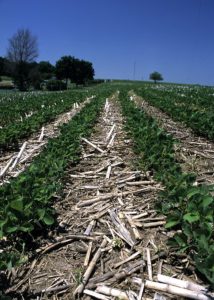
Soybeans growing in a field of corn residues from the previous year. The soybeans were planted with a no-till method.
One example of success comes from a region in northern China. The cradle of Chinese civilization, the so called Chinese Loess Plateau, was completely degraded into a desert by soil-destructive agriculture over thousands of years. In the late twentieth century, a restoration project was conceived based on terraces built over centuries by local communities. Liu was engaged in 1995 by the World Bank to film the progress on the Chinese Loess Plateau. He came out surprised by the results: the project massively restored carbon-sequestering biomass and food production. On a territory the size of France, small farmers’ agriculture incomes were multiplied by four. Since that time, with the financial support of the Commonland Foundation (Amsterdam), John Liu has started “ecosystem restoration camps.” The first camp is on degraded land in Spain, where Liu is trying “to grow a grassroots movement of everyday people dedicated to restoring degraded land.”
Documented reason for optimism also comes from the work of David Brandt and Gabe Brown in the United States. Using no-till techniques with diverse cover crops, both have multiplied the carbon in their soils many-fold, twenty times in the case of Brown, and have had amazing influence in their surroundings. In great part thanks to Brown’s ability to convince fellow farmers, some regions of North Dakota now reach 75% of no-till, up from 0% thirty years ago. This has occurred in regions that experienced the dust-bowl of the 1930s, and were heading in the same direction again before intervention. Changes due to no-till and regenerative agriculture are completely transforming a previously grim story.
Other successes have been realized through the movement of carbon ranching. In 2010, the Santa Fe, New Mexico–based Quivira Coalition organized a conference named “The Carbon Ranch: Using Food and Stewardship to Build Soil and Fight Climate Change.” It defines itself as follows:
Climate change is the most pressing issue confronting humanity. It is also a tremendous opportunity. Right now, the only possibility of large-scale removal of greenhouse gases from the atmosphere is through plant photosynthesis and other land-based carbon sequestration activities. Strategies include: enriching soil carbon, farming with perennials, employing climate-friendly livestock practices, conserving natural habitat, restoring degraded watersheds and rangelands, and producing local food. Over the past decade, many of these strategies have been demonstrated to be both practical and profitable. A carbon ranch bundles them into an economic whole with the aim of creating climate-friendly landscapes that are both healthy ecologically and the source of healthy food.
Following that event Courtney White wrote an important book, Grass, Soil, Hope — A Journey through Carbon Country. The book had a forward by famous food journalist Michael Pollan and was praised by Allan Savory and others of the movement for regenerative/restorative agriculture and animal husbandry. The Savory Institute network of hubs for holistic grazing management is itself another major documented initiative giving hope.
In Latin American tropical agriculture, in particular in Brazil, an alternative to unsustainable conventional agriculture has been proposed. It is called soil remineralization. According to Remineralize the Earth’s site, remineralization creates fertile soils by returning minerals to the soil in much the same way that the Earth does. During an Ice Age, glaciers crush rock onto the Earth’s soil mantle, and winds blow the dust in the form of loess all over the globe.
Volcanoes erupt, spewing forth minerals from deep within the Earth, and rushing rivers form mineral-rich alluvial deposits. Within silicate rocks is a broad spectrum of up to one hundred minerals and trace elements necessary for the well-being of all life and the creation of fertile soils. Glacial moraine or mixtures of single rock types can be applied to soils to create a sustainable and superior alternative to the use of ultimately harmful chemical fertilizers, pesticides, and herbicides.
Remineralization has been shown in scientific studies to achieve up to fourfold increases in agricultural yields and up to eightfold increases in forestry biomass. It produces both immediate and long-term benefits from a single application. Hundreds of thousands of tons of appropriate rock dust for soil and forest regeneration are stockpiled by the gravel and stone industry. Founder of Remineralize the Earth and co-editor and co-author of the book Geotherapy, Joanna Campe says: “Remineralization is one of the most important missions on the planet at this time. Together, we can remineralize gardens, farms, landscapes, and forests. We can grow nutrient-dense food and improve the nutrition and well-being of all life. And in the larger picture, it’s a key strategy to stabilize the climate!” According to the Brazilian network for organic farming, Organicsnet, “the government has published decree 8.384/2014 ruling law n. 12.890/2013, that includes rock-dust remineralization as an agriculture input.” Now that rock-dust is accepted in Brazil, companies can have their product analyzed for commercialization. In Mexico, Eco-Agro has been at the forefront of campaigns promoting the use of rock dust in and out of Mexico, highlighting both its fertilizing properties and its role in increasing plants’ resistance to disease and insect infestation.
At the Howard G. Buffett Foundation Centre for No-Till Agriculture (HGBF | CNTA), the motto is “WE ARE GROWING,” and their mission is to bring this motto to life “through the positive impact of conservation agricultural (CA) practices.” Over the past 10 years, the Foundation has partnered with Dr. Ko Boa in a mission to expand the adoption of conservation agriculture practices within the farmer population of Amanchia, Ghana.
HGBF | CNTA has successfully expanded its farmer base and has demonstrated measurable impacts of conservation agriculture. Boa says, “Conservation agriculture is not a single practice; it’s a basket of options. Wherever you are in the world, you can choose the relevant technologies to improve and sustain the productivity of soil.” The Centre transforms slashed vegetation into mulch layers that retain moisture and create nutrient-rich healthy soils. One of the most valuable attributes of conservation agriculture soil is the ability to conserve moisture, even in the most drought impacted regions. A protective layer of mulch prevents evaporation, while the roots of cover crops create a protective structure, thus preventing erosion. The nutrients of these soils are constantly being restored through decomposition of surface mulch and the resulting supportive micro-organisms that flourish in the moist environment below the field surface. Fields growing under conservation agriculture are naturally resistant to diseases, pests, and weeds. In this virtuous cycle, living soil systems remain productive indefinitely, allowing farmers to sustain their livelihoods on an ongoing basis. The results are amazingly rapid: 35% more yield, 45% decrease in labor, and 25% increase in disposable income in 2 years.
If we look at Australia, Bellotti and Rochecouste wrote, in International Soil and Water Conservation Research in 2014, that by virtue of the continent’s location in the mid-latitudes of the southern hemisphere, the climate over most of the continent is comparatively dry and highly variable from year to year. These characteristics (old, highly weathered, infertile soils, and low and variable rainfall) have shaped Australian agriculture, driving a relentless pursuit of innovation to remain productive, profitable, and sustainable.
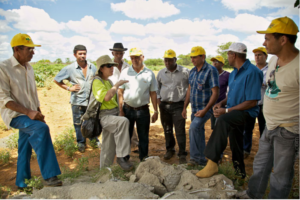
Professor Suzi Huff Theodoro with farmers in Bahia Brazil getting ready to add rock dust to their fields. Please check out our video Remineralization in Rural Brazil
Today, a significant majority of Australian farmers grow winter cereals using conservation agriculture principles. These principles include minimum or zero tillage, partial or full retention of crop residues to maintain soil cover, and rotation of cereals, oilseeds, and pulses (legumes) over time. Also in Australia, The Biochar Capacity Building Program complements the Carbon Farming Futures program. It builds on research undertaken through the National Biochar Initiative and the Soil Carbon Research Program funded under the Climate Change Research Program. (China is also very serious about biochar with some 50 plants in construction.)
While some of the soils for climate supports have known some ups and down — as it has been the case with Australia or California governments — the current trend allows for optimism. As we are writing, Great Britain has announced it is working on a law in favour of healthy soils. An optimism for solving the other half of the climate crisis, the half involving soils, must be documented. It includes the sequestration of carbon in living soils, and the abundance of healthy food. It is an optimism for a biosphere in which life will be massively restored.
Benoit Lambert, PhD is a member of the Soil4Climate advisory board; Biochar developer and geotherapist; owner of Biochar Génération; formally, Editor and Director of Publications, Worldwatch Institute, Geneva, Switzerland. He writes the blog Geotherapy Chronicle — For Food Security & Global Warming Reversal.
Linked Resources
- National Biochar Initiative http://www.agriculture.gov.au/ag-farm-food/climatechange/australias-farming-future/climate-change-and-productivity-research/biochar-research
- Soil Carbon Research Program http://www.agriculture.gov.au/ag-farm-food/climatechange/australias-farming-future/climate-change-and-productivity-research/soil_carbon
- Climate Change Research Program http://www.agriculture.gov.au/ag-farm-food/climatechange/australias-farming-future/climate-change-and-productivity-research
- Geotherapy Chronicle — For Food Security & Global Warming Reversal https://cologie.wordpress.com/
Support us on Patreon
Thank you for joining us today! Please become a member of RTE and support us on Patreon. Unlike many larger organizations, we work with a team of determined and passionate volunteers to get our message out. We aim to continue to increase the awareness of remineralization to initiate projects across the globe that remineralize soils, grow nutrient dense food, regenerate our forests’ and stabilize the climate – with your help! If you can, please support us on a monthly basis from just $2, rest assured that you are making a big impact every single month in support of our mission. Thank you!

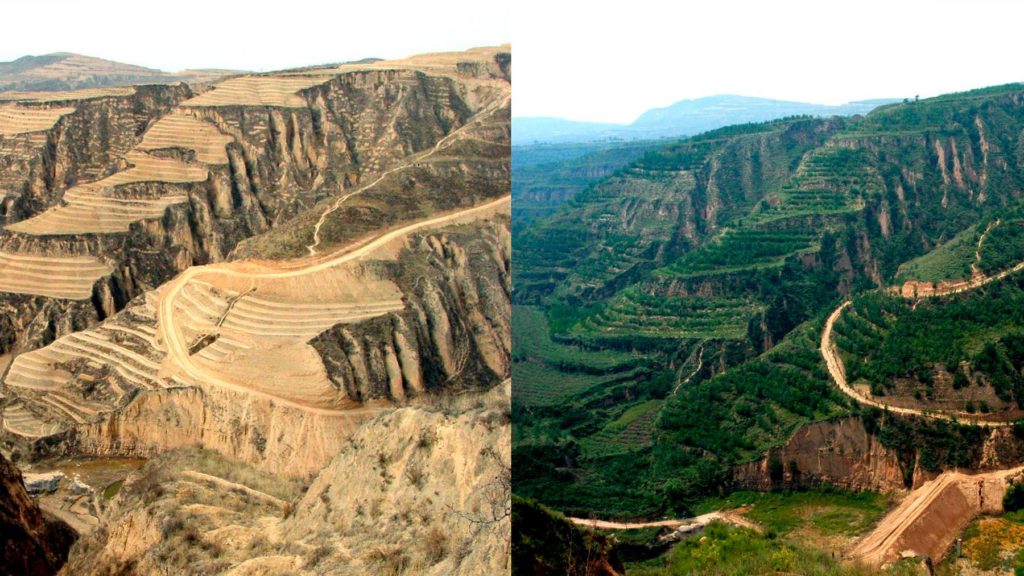

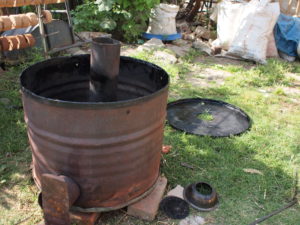
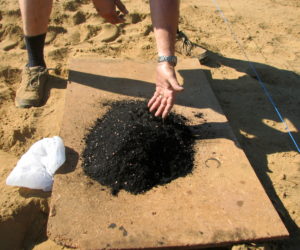
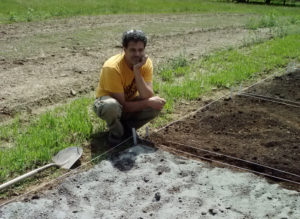






Got something to say?